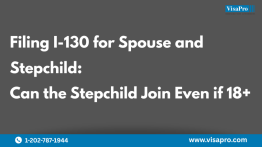Introduction
US Congress, by conferring the ability to grant permanent residence based on familial relationships has properly recognized the importance of family reunification in American immigration law. The Immigration and Nationality Act (INA) provides for immigrant visas for certain foreign nationals based upon their familial relationship to a U.S. citizen (USC) or Lawful Permanent Resident (LPR).
Family-based Immigration falls under two basic categories:
- Immediate relatives of USC’s and
- The Preference Categories (other relatives of USC’s and LPR’s).
Immediate Relatives Of United States Citizens
480,000 immigrant visas are set aside for family-based immigrant visas. However, Immediate Relatives of US Citizens are exempt from this quota. Within this group are spouses of USC’s, unmarried children under the age of 21 of USC’s, and the parents of USC’s.
1. Spouses of a USC:
The spouse of a USC qualifies as an immediate relative as long as the marriage is legal in the country where the marriage took place, and it is not in contravention of US laws.
If either the husband or wife was previously married, a legally valid divorce or annulment or death certificate must be presented.
2. Children:
To qualify as a child for immediate relative status the child of a USC must be unmarried, and under the age of 21 years. Within the context of US immigration law “child” is very specifically defined. For children born in wedlock, the relationship to either the father or the mother will be sufficient to qualify the child for an immigrant visa.
For children born out of wedlock, the relationship through the mother will always qualify because it can be easily proved. However, the relationship through the father will qualify in only two circumstances. The father must show that
(1) evidence exists which clearly demonstrates a parent/child relationship exists, such as the father financially supporting or living with the child, or
(2) the father, before the child’s 18th birthday, has “legitimated” the child in the manner prescribed by law in the country where the child is living.
Stepchildren, adopted children, and “eligible orphans” are also included in the definition of “child.” Stepchildren are treated like a child of the petitioner as long as the stepchild relationship was created before the child’s eighteenth birthday. Adopted children are considered children for immigration purposes as long as they were legally adopted before the age of sixteen, and they have been in the legal custody and have physically resided with the adopting parent for 2 years. Eligible orphans must meet the very specific definition of “orphan” to qualify.
3. Parents:
The parents of a USC are eligible provided that the USC son or daughter who is filing the petition is at least 21 years of age. Additionally, the US citizen must be the “child” of the parent seeking permanent residence, as defined by US immigration law and described above.
Advantages of The Immediate Relative Category:
- There is no numerical limit to the number of visas which can be issued to immediate relatives. This means that there is no backlog and the process should normally not take more than 1-2 years.
- If the immediate relative is in the U.S. and entered the U.S. legally and was inspected, they can always file for Adjustment of Status, even if he or she subsequently fell out of status and/or is accruing unlawful presence.
Disadvantages of The Immediate Relative Category:
- Derivative relatives of the foreign national family members cannot immigrate with the primary beneficiary.
For example: A USC files an I-130 petition for her parents. She also has a 13-year-old brother. Her brother cannot immigrate to the U.S. as a derivative or accompanying family member of either of her parents. Either the USC must file a separate petition for her brother (which will take many years- see below) or one of her parents will need to file an I-130 once they have become LPR’s (see below) which will take at approximately 2-3 years. - Each immediate family member needs his or her own immigrant visa petition. That means that if a USC is sponsoring his/her spouse and children, the spouse and each child needs their own individual I-130.
- Spouses of U S citizens who have been married for less than 2 years at the time they obtain lawful permanent residence their green cards are subject to a 2 year period of “conditional” residence. The conditional resident must then file form I-751 just prior to the expiration of their green card to “remove” the conditions.

The Preference Categories For Family Members Of USC’S And LPR’s
Qualifying family members of USC’s and LPR’s are subject to the 480,000 numerical quota set aside for family based immigration. While Congress has found that these relationships provide important family ties, they do not raise to the level of the immediate relatives.
Numerical Limit: The 480,000 quota is divided between the 4 preference categories. Furthermore, each country cannot be given more than 7% of the numerical limit for each category. Because of the numerical limitations on each of the categories and the countries, there is generally a waiting period before a beneficiary (the sponsored relative) can get an immigrant visa and come to the US. The wait times are listed in the State Department Visa Bulletin and range from 1 ½-3 years for the F2A category the spouse of a permanent resident to approximately 20+ years for the brother or sister of US citizen from the Philippines.
Family Based Preference Categories: This category of immigrant visas has been subdivided into preference categories based on the closeness of the relationship of the beneficiary to the petitioner. The preference categories are:
1. First Preference or F1- Unmarried adult sons and daughters of USC’s. This preference category is given 23,400 visas each year.
2. Second Preference or F2A and F2B- the spouse and minor children (under 21) of LPR’s (F2A) and the unmarried adult sons and daughters of LPR’s. The entire category is given 114,200 visas annually, with the vast majority going to F2A. As with immediate relatives of USC’s, the spouse of a permanent resident is granted permanent residence status on a “conditional” basis if they have been married for less than 2 years at the time permanent residence is granted. However, because of the wait times for this category, it is rare that an F2 spouse will be given the conditional status.
3. Third Preference or F3- Married sons and daughters of USC’s (that is- children of USC’s that are married, of any age). This group receives 23,400 visas each year. As always, each son or daughter must have, at some earlier point, met the definition of “child” for immigration law purposes.
4. Fourth Preference or F4- Brothers and Sisters of USC’s. Similar to sponsoring parents, the USC must be 21 to petition for a sibling.
Advantages of The Family Preference Categories:
- Unlike most countries, the US allows for sponsorship of close relatives, even siblingss.
- The Preference Categories is the ability for “derivative” family members to immigrate to the U.S. with the primary beneficiary. The immediate family members (i.e., spouses and unmarried children under the age of 21) of immigrants qualifying under each of these four family preference categories are permitted to concurrently immigrate as well.
For example: A USC files an I-130 on behalf of his 26-year-old, unmarried daughter. She has a 2-year-old child. The child will be able to immigrate to the U.S. with his/her mother on the basis of the mother’s petition.
Disadvantages of The Family Preference Categories:
The primary disadvantage of the Family Preference Categories is the long wait times in the F-1, F-3 and F-4, especially for those born in Mexico and the Philippines.
Documentation Required
To complete the process of filing for a relative, the USC or LPR petitioner must prepare and submit the following to U.S. Citizenship & Immigration Services:
- USCIS Form I-130, Petition for Alien Relative
- Evidence of the relationship between the USC or LPR petitioner and the foreign national relative
- For spouses- marriage certificate and evidence of termination of any previous marriage(s)
- For children- birth certificate and/or secondary evidence showing the parent/child relationship
- For siblings- birth certificates of all parties showing that the petitioner and beneficiary share at least 1 parent
- Proof of the Petitioner’s US citizenship or LPR status
- The USC petitioner should submit proof of US citizenship, which can include a copy of their US birth certificate or Consular Report of Birth Abroad, US passport, Naturalization Certificate or Certificate of Citizenship
- The LPR petitioner must submit a copy of the green card or valid I-551 stamp
- The USCIS filing fee of $535
- Form G-28 (Notice of Appearance for the Attorney or Representative) if represented by counsel.
The I-130 package is filed with the USCIS Lockbox which has jurisdiction over the Petitioner place of residence.
Conclusion
Family based immigration has many benefits for US citizens or permanent residents that want to be reunited with family, be it a spouse and children, a newly adopted child, parents or brothers and sisters. Congress’ recognition of the importance of family has kept millions of family units together and the U.S. has only benefitted from this.
For more information about family-based immigration or to see if you can sponsor a family member, please consult with the experienced immigration attorneys at http://consultattorney.visapro.com
What VisaPro Customers Are Saying
I would have no hesitation recommending Visapro. They dealt with my case professionally and I appreciated the way they made themselves available over the phone when I needed clarification or to ask a question………. I am very happy I chose them to manage my visa application and grateful for their support right through to successfully acquiring my Green Card.”
 Michelle, Chicago
Michelle, Chicago



